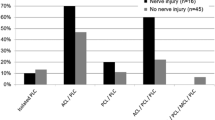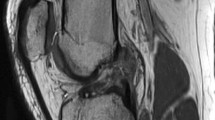Abstract
Purpose
The purpose of this study was to identify if the location of posterolateral corner (PLC) injury was predictive of clinical common peroneal nerve (CPN) palsy.
Methods
A retrospective chart review was conducted of patients presenting to our institution with operative PLC injuries. Assessment of concomitant injuries and presence of neurologic injury was completed via chart review and magnetic resonance imaging (MRI) review. A fellowship-trained musculoskeletal radiologist reviewed the PLC injury and categorized it into distal, middle and proximal injuries with or without a biceps femoral avulsion. The CPN was evaluated for signs of displacement or neuritis.
Results
Forty-seven operatively managed patients between 2014 and 2019 (mean age-at-injury 29.5 ± 10.7 years) were included in this study. Eleven (23.4%) total patients presented with a clinical CPN palsy. Distal PLC injuries were significantly associated with CPN palsy [9 (81.8%) patients, (P = 0.041)]. Nine of 11 (81.8%) patients with CPN palsy had biceps femoral avulsion (P = 0.041). Of the patients presenting with CPN palsy, only four (36.4%) patients experienced complete neurologic recovery. Three of 7 patients (43%) with an intact CPN had full resolution of their clinically complete CPN palsy at the time of follow-up (482 ± 357 days). All patients presenting with a CPN palsy also had a complete anterior cruciate ligament (ACL) rupture in addition to a PLC injury (P = 0.009), with or without a posterior cruciate ligament (PCL) injury. No patient presenting with an isolated pattern of PCL-PLC injury (those without ACL tears) had a clinical CPN palsy.
Conclusion
Distal PLC injuries have a strong association with clinical CPN palsy, with suboptimal resolution in the initial post-operative period. Specifically, the presence of a biceps femoris avulsion injury was highly associated with a clinical CPN palsy. Additionally, CPN palsy in the context of PLC injury has a strong association with concomitant ACL injury. Furthermore, the relative rates of involvement of the ACL vs. PCL suggest that specific injury mechanism may have an important role in CPN palsy.
Level of evidence
IV.




Similar content being viewed by others
References
Baker CL Jr, Norwood LA, Hughston JC (1983) Acute posterolateral rotatory instability of the knee. J Bone Joint Surg Am 65:614–618
Becker EH, Watson JD, Dreese JC (2013) Investigation of multiligamentous knee injury patterns with associated injuries presenting at a level I trauma center. J Orthop Trauma 27:226–231
Bloom DA, Essilfie AA, Lott A, Alaia EF, Hurley ET, Grabberhaus S et al (2020) Distal biceps Femoris Avulsions: associated injuries and neurological sequelae. Knee 27(6):1874–1880. https://doi.org/10.1016/j.knee.2020.07.085
Chahla J, Moatshe G, Dean CS, LaPrade RF (2016) Posterolateral corner of the knee: current concepts. Arch Bone Joint Surg 4:97–103
Dean RS, DePhillipo NN, Kahat DH, Graden NR, Larson CM, LaPrade RF (2020) Low-energy multiligament knee injuries are associated with higher postoperative activity scores compared with high-energy multiligament knee injuries: a systematic review and meta-analysis of the literature. Am J Sports Med. https://doi.org/10.1177/0363546520962088363546520962088
Engebretsen L, Risberg MA, Robertson B, Ludvigsen TC, Johansen S (2009) Outcome after knee dislocations: a 2–9 years follow-up of 85 consecutive patients. Knee Surg Sports Traumatol Arthrosc 17:1013–1026
Entwisle T, Ling Y, Splatt A, Brukner P, Connell D (2017) Distal musculotendinous T junction injuries of the biceps Femoris: an MRI case review. Orthop J Sports Med 5:2325967117714998
Everhart JS, Du A, Chalasani R, Kirven JC, Magnussen RA, Flanigan DC (2018) Return to work or sport after multiligament knee injury: a systematic review of 21 studies and 524 patients. Arthroscopy 34:1708–1716
Garozzo D, Ferraresi S, Buffatti P (2004) Surgical treatment of common peroneal nerve injuries: indications and results. A series of 62 cases. J Neurosurg Sci 48:105–112 ((discussion 112))
Hughston JC, Andrews JR, Cross MJ, Moschi A (1976) Classification of knee ligament instabilities. Part I the medial compartment and cruciate ligaments. J Bone Joint Surg Am 58:159–172
Johnson ME, Foster L, DeLee JC (2008) Neurologic and vascular injuries associated with knee ligament injuries. Am J Sports Med 36:2448–2462
Kahan JB, Li D, Schneble CA, Huang P, Bullock J, Porrino J et al (2020) The pathoanatomy of posterolateral corner ligamentous disruption in multiligament knee injuries is predictive of peroneal nerve injury. Am J Sports Med 48:3541–3548
Kayani B, Ayuob A, Begum F, Singh S, Haddad FS (2020) Surgical repair of distal musculotendinous T junction injuries of the biceps femoris. Am J Sports Med 48:2456–2464
Kim DH, Murovic JA, Tiel RL, Kline DG (2004) Management and outcomes in 318 operative common peroneal nerve lesions at the Louisiana State University Health Sciences Center. Neurosurgery 54:1421–1428 ((discussion 1428-1429))
Krych AJ, Giuseffi SA, Kuzma SA, Stuart MJ, Levy BA (2014) Is peroneal nerve injury associated with worse function after knee dislocation? Clin Orthopaed Relat Res 472:2630–2636
LaPrade RF, Gilbert TJ, Bollom TS, Wentorf F, Chaljub G (2000) The magnetic resonance imaging appearance of individual structures of the posterolateral knee. A prospective study of normal knees and knees with surgically verified grade III injuries. Am J Sports Med 28:191–199
LaPrade RF, Johansen S, Agel J, Risberg MA, Moksnes H, Engebretsen L (2010) Outcomes of an anatomic posterolateral knee reconstruction. J Bone Joint Surg Am 92:16–22
LaPrade RF, Ly TV, Wentorf FA, Engebretsen L (2003) The posterolateral attachments of the knee: a qualitative and quantitative morphologic analysis of the fibular collateral ligament, popliteus tendon, popliteofibular ligament, and lateral gastrocnemius tendon. Am J Sports Med 31:854–860
LaPrade RF, Terry GC (1997) Injuries to the posterolateral aspect of the knee. Association of anatomic injury patterns with clinical instability. Am J Sports Med 25:433–438
LaPrade RF, Tso A, Wentorf FA (2004) Force measurements on the fibular collateral ligament, popliteofibular ligament, and popliteus tendon to applied loads. Am J Sports Med 32:1695–1701
LaPrade RF, Wozniczka JK, Stellmaker MP, Wijdicks CA (2010) Analysis of the static function of the popliteus tendon and evaluation of an anatomic reconstruction: the “fifth ligament” of the knee. Am J Sports Med 38:543–549
Lee PP, Chalian M, Bizzell C, Williams EH, Rosson GD, Belzberg AJ et al (2012) Magnetic resonance neurography of common peroneal (fibular) neuropathy. J Comput Assist Tomogr 36:455–461
Medina O, Arom GA, Yeranosian MG, Petrigliano FA, McAllister DR (2014) Vascular and nerve injury after knee dislocation: a systematic review. Clin Orthop Relat Res 472:2621–2629
Moatshe G, Dornan GJ, Løken S, Ludvigsen TC, LaPrade RF, Engebretsen L (2017) Demographics and injuries associated with knee dislocation: a prospective review of 303 patients. Orthop J Sports Med 5:2325967117706521
Niall DM, Nutton RW, Keating JF (2005) Palsy of the common peroneal nerve after traumatic dislocation of the knee. J Bone Joint Surg Br 87:664–667
Plancher KD, Siliski J (2008) Long-term functional results and complications in patients with knee dislocations. J Knee Surg 21:261–268
Potter HG, Weinstein M, Allen AA, Wickiewicz TL, Helfet DL (2002) Magnetic resonance imaging of the multiple-ligament injured knee. J Orthop Trauma 16:330–339
Ridley TJ, McCarthy MA, Bollier MJ, Wolf BR, Amendola A (2018) The incidence and clinical outcomes of peroneal nerve injuries associated with posterolateral corner injuries of the knee. Knee Surg Sports Traumatol Arthrosc 26:806–811
Rios CG, Leger RR, Cote MP, Yang C, Arciero RA (2010) Posterolateral corner reconstruction of the knee: evaluation of a technique with clinical outcomes and stress radiography. Am J Sports Med 38:1564–1574
Ryan W, Mahony N, Delaney M, O’Brien M, Murray P (2003) Relationship of the common peroneal nerve and its branches to the head and neck of the fibula. Clin Anat 16:501–505
Sanders TL, Johnson NR, Levy NM, Cole PA Jr, Krych AJ, Stuart M et al (2017) Effect of vascular injury on functional outcome in knees with multi-ligament injury: a matched-cohort analysis. J Bone Joint Surg Am 99:1565–1571
Terry GC, LaPrade RF (1996) The biceps femoris muscle complex at the knee. Its anatomy and injury patterns associated with acute anterolateral-anteromedial rotatory instability. Am J Sports Med 24:2–8
Treme GP, Salas C, Ortiz G, Gill GK, Johnson PJ, Menzer H et al (2019) A biomechanical comparison of the Arciero and LaPrade reconstruction for posterolateral corner knee injuries. Orthop J Sports Med 7:2325967119838251
Vieira RL, Rosenberg ZS, Kiprovski K (2007) MRI of the distal biceps femoris muscle: normal anatomy, variants, and association with common peroneal entrapment neuropathy. AJR Am J Roentgenol 189:549–555
Worley JR, Brimmo O, Nuelle CW, Cook JL, Stannard JP (2019) Incidence of concurrent Peroneal nerve injury in multiligament knee injuries and outcomes after knee reconstruction. J Knee Surg 32:560–564
Author information
Authors and Affiliations
Corresponding author
Ethics declarations
Conflict of interest
The authors declare that they have no conflict of interest.
Funding
No funding was provided for this manuscript.
Ethical Approval
Ethical approval from the New York University Institutional Review Board ID 19-01430.
Additional information
Publisher's Note
Springer Nature remains neutral with regard to jurisdictional claims in published maps and institutional affiliations.
Rights and permissions
About this article
Cite this article
Essilfie, A.A., Alaia, E.F., Bloom, D.A. et al. Distal posterolateral corner injury in the setting of multiligament knee injury increases risk of common peroneal palsy. Knee Surg Sports Traumatol Arthrosc 30, 239–245 (2022). https://doi.org/10.1007/s00167-021-06469-z
Received:
Accepted:
Published:
Issue Date:
DOI: https://doi.org/10.1007/s00167-021-06469-z




